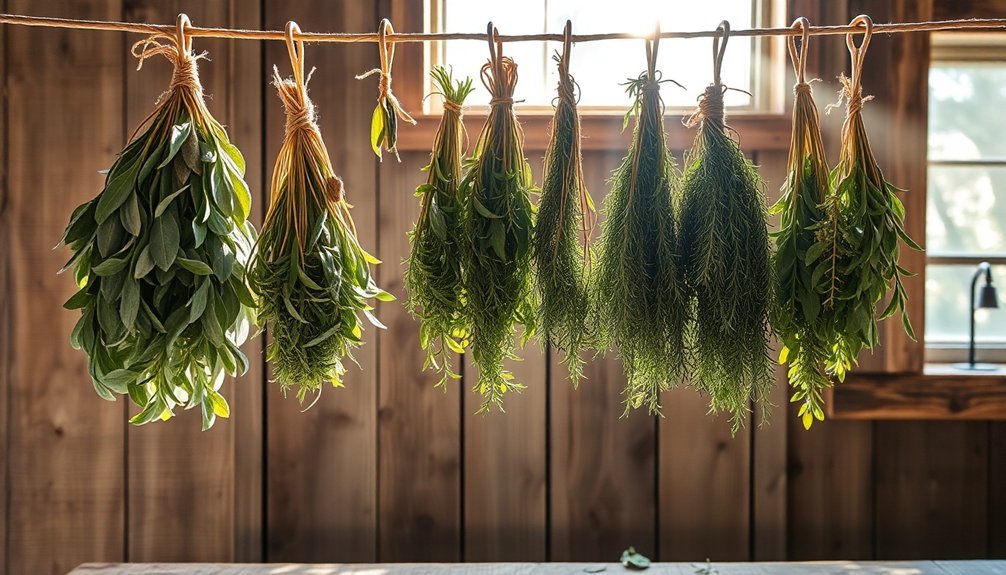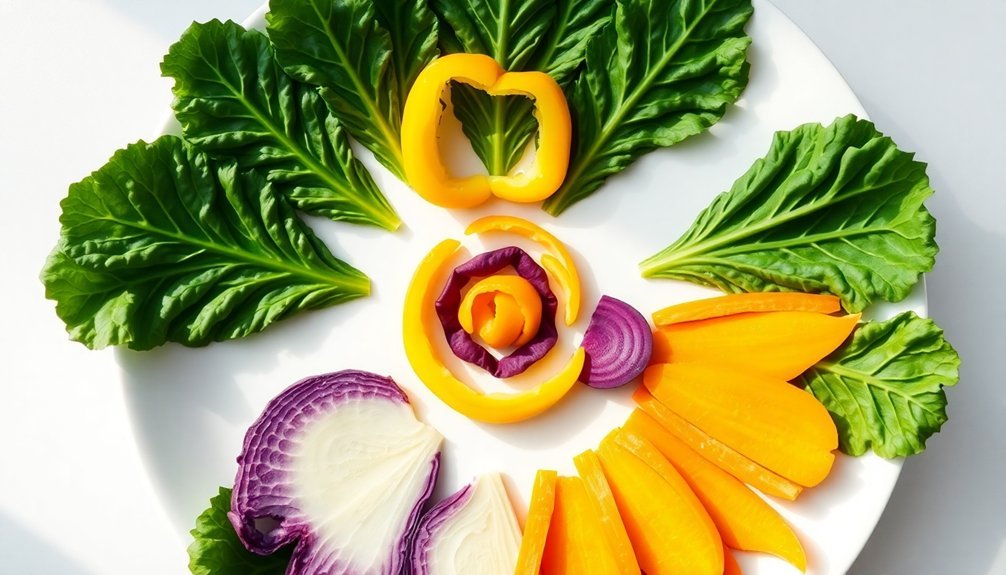Sun-drying herbs at home lets you naturally preserve your garden's bounty while maintaining essential oils, flavors, and nutrients. You'll want to harvest herbs in the morning after the dew evaporates, then clean and prepare them for drying. Choose a well-ventilated location with temperatures between 70-80°F, and protect your herbs from direct sunlight using screened racks or ventilated paper bags. The process takes about two weeks for air drying, and you'll know they're ready when stems snap cleanly. With proper storage in airtight containers, your dried herbs can last up to two years. Our detailed guide will help you master this ancient preservation technique.
Benefits of Solar Herb Drying

Solar herb drying stands out as one of the most efficient and environmentally friendly methods for preserving herbs. You'll benefit from considerable cost savings, as solar dryers can operate for 15-20 years with minimal maintenance expenses. Clean dried products result from the controlled drying environment that minimizes exposure to environmental pollutants.
By harnessing renewable energy, you're reducing your dependency on fossil fuels while maintaining a sustainable preservation practice.
The quality of your dried herbs will be exceptional, as solar drying effectively preserves their nutritional content, flavor, and natural color. You'll achieve ideal moisture levels around 10%, which prevents the growth of harmful microorganisms and extends shelf life.
The controlled environment protects your herbs from UV damage, maintaining their vibrant green color.
You'll appreciate the improved efficiency of solar dryers, which can reach temperatures up to 72°C, considerably faster than traditional drying methods.
Even on cloudy days, you can continue drying operations thanks to heat retention capabilities. The stackable tray system means you'll save space while drying multiple batches simultaneously.
Best of all, you're ensuring food safety by protecting your herbs from dust, insects, and other contaminants, resulting in a cleaner, more hygienic final product.
Selecting the Perfect Drying Location
When choosing between indoor and outdoor drying locations, you'll need to weigh the convenience of indoor spots against the natural ventilation of outdoor areas.
You'll want to shield your herbs from direct sunlight and protect them from rain, wind, and debris by using covered areas or paper bags with ventilation holes. Select areas with cool, dark conditions to help preserve the essential oils and flavor potency of your dried herbs.
Whether inside or out, select a space with consistent airflow and low humidity to guarantee your herbs dry evenly and maintain their quality.
Indoor Vs Outdoor Spots
Choosing between indoor and outdoor drying spots can greatly impact your herbs' final quality and potency. Indoor locations offer superior color and flavor retention, with warm, dry areas like attics and kitchens being ideal choices.
You'll want to avoid humid spaces and direct sunlight, using paper bags or muslin with ventilation holes to protect your herbs while allowing proper air circulation.
While outdoor drying is possible, it's less reliable and can lead to flavor and color loss. If you're considering outdoor spots, you'll need temperatures around 100°F and humidity below 60%. Consider placing herbs on drying screens or in a parked car on sunny days for effective results.
You'll also have to bring your herbs inside at night to prevent moisture damage, though a DIY solar food dryer can make outdoor drying more effective.
Regardless of your chosen location, proper air circulation is essential. Use twist-ties and perforated bags to guarantee even drying as stems shrink.
If you're drying indoors, maintain consistent, moderate temperatures and avoid direct sunlight. For ideal results, consider using drying screens or cheesecloth to enhance airflow.
You can even use your refrigerator for cold drying, which helps preserve color, flavor, and fragrance.
Protection From Elements
Protecting your herbs from harmful elements requires strategic placement in your drying location. You'll need to find a spot that shields your herbs from direct sunlight, as UV rays can degrade essential oils and diminish both flavor and magical properties.
Choose a cool, shaded area where your herbs won't be exposed to intense heat, which can cause rapid drying and loss of potency. Proper ventilation is vital to prevent moisture buildup and mold growth, especially for tender leaf herbs.
If you're in a humid climate, you'll want to guarantee good airflow while keeping the herbs protected. Using cheesecloth or netting screens can help shield your herbs from dust and other contaminants while allowing air circulation.
Before placing your herbs in their drying spot, rinse them thoroughly and pat them dry with paper towels. Remove any bruised or imperfect leaves to prevent contamination.
Don't forget to label your herbs clearly to avoid mix-ups later. Remember to store your dried herbs in a cool, dark place once they're completely dry.
Optimal Air Circulation
The perfect drying location starts with ideal air circulation. You'll want to choose a spot with low humidity and good ventilation, staying far from moisture-heavy areas like sinks and dishwashers. Position your herbs in a dimly lit indoor space to maintain their vibrant colors and robust flavors.
To maximize airflow, hang your herb bundles with enough space between them, using rubber bands that naturally tighten as the stems shrink. Cover them with perforated paper bags to protect from dust while allowing air movement. For smaller herbs, lay them flat on screens or paper towels, making sure they don't touch.
| Location Features | Benefits | Risks to Avoid |
|---|---|---|
| Low Humidity | Prevents mold growth | Moisture-rich areas |
| Good Ventilation | Guarantees even drying | Stagnant air pockets |
| Indirect Light | Preserves color & flavor | Direct sunlight exposure |
Monitor your herbs regularly, checking for even drying and any signs of mold. The process typically takes up to two weeks, and you'll know they're ready when the leaves crumble easily and stems snap cleanly. Remember to change paper towels frequently if you're using them, as they'll absorb moisture from your herbs.
Essential Tools for Sun Drying

You'll need several basic tools to start drying herbs, including drying racks or screened trays for proper air circulation, and twine or rubber bands to secure herb bunches.
Creating your own drying racks is simple – you can transform old window screens or bamboo mats into effective drying surfaces by elevating them on blocks for airflow.
Whether you choose store-bought or DIY equipment, make sure your drying tools are clean, well-ventilated, and sturdy enough to support your herbs throughout the drying process.
Basic Equipment Needs
Successful herb drying starts with gathering the right tools and equipment for the job. You'll need sharp scissors or pruning shears for harvesting, and clean string or twine for bundling your herbs into small bunches.
Brown paper bags with ventilation holes are essential to protect your drying herbs from dust while maintaining proper air circulation.
For tray drying, you'll want to invest in screened surfaces that allow air to flow freely around your herbs. Cheesecloth is particularly useful when you're working with delicate blossoms or seed heads, as it keeps small parts from falling through the screens while still allowing moisture to escape.
Paper towels are necessary if you plan to use the oven-drying method.
Storage containers are equally important to your drying success. You'll need airtight glass jars for testing the dryness of your herbs and eventual storage. These containers should be thoroughly cleaned and completely dry before use.
Don't forget to keep basic monitoring tools on hand, such as moisture meters or simple jar-testing supplies, to guarantee your herbs are properly dried before final storage.
DIY Drying Racks
Building a DIY drying rack forms the foundation of effective sun-drying for herbs. You'll need 1.5" wood cut into 24" and 21" lengths to create a sturdy square frame that's both lightweight and durable. Pre-drill holes to prevent splitting, and secure the pieces with 3" screws.
To add the drying surface, you can repurpose an old window screen. Lay it across your wooden frame and secure it with a staple gun, keeping the mesh taut but not overstretched. For added strength, wrap the screen around the frame's edges and staple it on the reverse side. Don't forget to fold the corners neatly before securing them.
You'll want to position your completed rack above a flat surface to guarantee proper air circulation. It's versatile too – you can stack multiple racks and rotate them periodically for even drying.
Once you've washed and trimmed your herbs, spread them across the screen and let the sun do its work. When they're completely dry, transfer them to airtight mason jars for storage.
This simple rack isn't limited to herbs; you can use it for drying tomatoes, fruits, and even homemade pasta.
Preparing Herbs Before Drying
Before starting the drying process, proper herb preparation is essential for achieving the best results. You'll want to harvest your herbs in the early morning after the dew has evaporated, selecting fresh tip growth with no signs of bruising or imperfections. Cut stems about 6 inches below the flower buds, and time your harvest just before the herbs flower when their essential oils are at their peak.
Clean your herbs by gently rinsing them in cool water, then pat or shake them dry. For larger-leafed herbs like basil and mint, remove the leaves from stems, while keeping smaller-leafed varieties like oregano and thyme intact on their stems.
| Herb Type | Preparation Method | Storage Prep |
|---|---|---|
| Large-leaf | Remove from stems | Bundle loose leaves |
| Small-leaf | Keep on stems | Tie in small bundles |
| Flowering | Cut below buds | Hang upside down |
| Delicate | Single layer spread | Use drying screens |
| Aromatic | Gentle handling | Paper bag cover |
Once cleaned, you'll need to arrange your herbs properly. Create small bundles using string or twine for hanging, or spread them in single layers on drying racks. Cover hanging bundles with perforated paper bags to protect from dust while maintaining airflow.
Monitoring the Drying Process

Throughout the drying process, careful monitoring of your herbs guarantees ideal preservation of their flavor, color, and medicinal properties.
You'll need to check several key factors to verify successful drying, starting with environmental conditions. Keep your herbs in a well-ventilated area with temperatures between 70-80°F, away from direct sunlight and high-moisture areas that could promote mold growth.
Watch for specific signs that indicate proper drying progress. Your herbs should become brittle and crumbly when they're ready, with stems that snap rather than bend. They should maintain their original color and distinct aroma throughout the process.
If you're using different drying methods, remember that timing varies greatly – air drying takes about two weeks, while oven drying requires only 2-4 hours at the lowest setting.
When using equipment, maintain proper settings and arrangement. Set your dehydrator between 95-115°F, or keep your oven at its lowest temperature with the door slightly ajar.
Always arrange herbs in single layers to verify even drying, and protect outdoor-drying herbs with cheesecloth to keep insects away.
Testing for Complete Dehydration
To determine if your herbs are completely dehydrated, you'll need to perform several physical tests. Try crumbling the herbs between your fingers – they should break apart easily without any resistance. The stems should snap cleanly when bent, rather than flexing or bending. You'll know your herbs are ready when the leaves and seeds readily fall from the stems.
Perform a thorough visual inspection of your dried herbs. Look for any signs of moisture, mold, or mildew, which indicate incomplete drying. The herbs should maintain their natural color, though some fading is normal with sun drying.
When you touch them, they shouldn't feel damp or sticky, and the texture should be consistently crumbly rather than powdery.
Once you've confirmed complete dehydration, you can prepare your herbs for storage. You'll want to either leave them whole or crumble them coarsely before placing them in airtight containers.
Store your dried herbs in a cool, dry place away from direct sunlight to maintain their flavor and aroma. Remember, any exposure to moisture can lead to spoilage, so verify your storage containers are completely sealed.
Long Term Storage Methods

For successful long-term herb storage, proper containers and conditions are essential. Choose glass jars or metal tins with screw-top or clamp-on lids, and avoid plastic containers that can leach chemicals. Before storing, crush or crumble your dried herbs to maximize storage space and enhance their flavor release.
You'll want to keep your herbs in a cool, dry place away from direct sunlight, as UV rays can degrade their potency and nutritional value. Dark-colored glass jars provide extra protection, while pantries, cupboards, or root cellars offer ideal storage locations.
Don't store herbs near heat sources or in humid areas like bathrooms.
When you're organizing your storage system, label each container with the herb type and preservation date. This practice helps you track freshness and use older herbs first.
Remember that different herbs have varying shelf lives: dried leaves and flowers last 1-2 years, roots and seeds can stay fresh for 2-3 years, while powdered herbs should be used within 6-12 months. If you're storing herbal powders, you can extend their shelf life by keeping them in the refrigerator or freezer.
Frequently Asked Questions
Can Herbs Be Sun-Dried During Winter Months in Cold Climates?
No, you can't effectively sun-dry herbs during winter in cold climates. You'll face challenges with limited sunlight, low temperatures, and high humidity. Instead, try using indoor methods like air-drying or dehydrators.
What Should I Do if My Herbs Develop Mold During Drying?
If you notice mold, immediately discard affected herbs. You'll need to move remaining herbs to a faster drying method, like a dehydrator, and improve air circulation. Don't try to salvage moldy portions.
How Do Different Herb Varieties Affect Sun-Drying Time?
You'll find herbs with higher moisture content, like mint (86.34%), take longer to dry. Thicker leaves need more time too. The presence of essential oils and other chemical compounds in different varieties also affects drying duration.
Are Certain Herbs Unsuitable for Sun Drying?
Yes, you shouldn't sun-dry tender-leaf herbs like basil, oregano, tarragon, mint, and lemon balm. They'll likely lose flavor, color, and might develop mold due to their high moisture content. Use dehydrators or indoor methods instead.
Can Sun-Dried Herbs Be Used in the Same Quantities as Fresh?
You'll need to use less sun-dried herbs than fresh since they're 3-4 times more concentrated. As a general rule, use 1 teaspoon of dried herbs for every tablespoon of fresh herbs called for.
In Summary
You'll find that sun-drying herbs is a rewarding way to preserve your garden's bounty while maintaining their natural flavors and medicinal properties. By following proper drying techniques and storage methods, you're able to enjoy these herbs year-round. Remember to always check for complete dehydration before storing, and you'll have a sustainable supply of homegrown herbs ready whenever you need them.





Leave a Reply